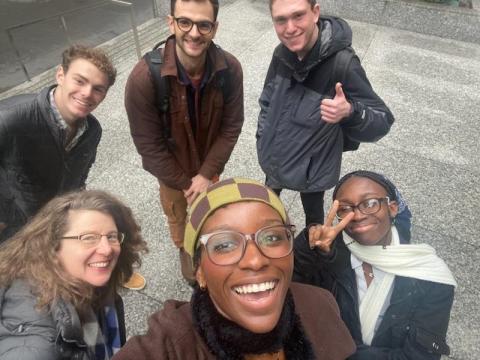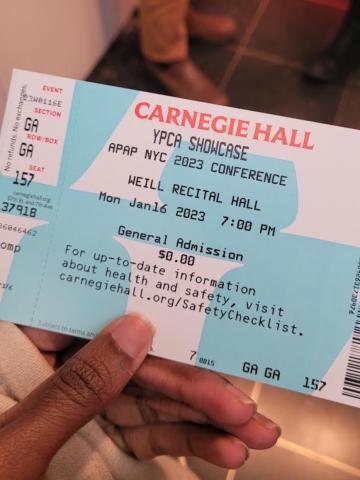A Laboratory for Concert Programming
by Victoria Henry '25
February 16, 2023

The Music@Amherst Curation Lab was put together by Manager of Concert Programming, Production, and Publicity, Alisa Pearson, assisted by Graduate Associate in Music, Dan Langa with the intention of taking a group of students with an interest in presenting and curation to NYC to attend a variety of presenting conferences that happen there in January. Following this experience, the students got the chance to submit artist proposals to the Music@Amherst concert series, meet with the Loeb Center for Career Exploration and Planning, and get to talk about the curator-audience dynamic with Professor Harper's “Live Music” class.
This project was put together for a variety of reasons. For Pearson, the Curation Lab is the realization of a longtime goal. All the pieces finally fell into place this year with the green light from the Music faculty, a very special cohort of interested students from across the College, and a great partner in Dan Langa '18, who is both a recent AC graduate and has a professional interest in curation. The project also benefited greatly from generous support of the Office of Diversity Equity and Inclusion, Student Affairs, and the Loeb Center.
"You want to engage in a conversation, so the learning can move in both directions – that is, meet the students where they are, finding inspiration in what motivates them, and also shining a light on ways the curriculum connects to these performances, and thus opens doors to new experiences and horizons." --Concert Manager Alisa Pearson
A major goal of this project is to increase the relevance of Music@Amherst events for students by creating a dialogue around artist selection. “You’re not creating community when you simply say, ‘Come to this concert,’ nor is it a good idea to only ask, ‘What do you want? I’ll just do what you want,' says Pearson. "You want to engage in a conversation, so the learning can move in both directions – that is, meet the students where they are, finding inspiration in what motivates them, and also shining a light on ways the curriculum connects to these performances, and thus opens doors to new experiences and horizons. Students come to Amherst to learn new things, and a concert can be so many things at once: a pleasure, a revelation, a way to be in community as members of a live audience. We had rich conversations about those things during the Curation Lab, and look forward to finding ways to keep learning from one another."
For Langa, the intent was exposing students to the wide variety of careers there are in music. “The personal main goal with the Curation Lab is showing students that beyond just being a world famous soloist, there’s a lot of ways you can contribute to music or contribute to a community… For whatever genre or scene you’re in, there’s ways to contribute and have that be a part of your profession.”
In searching for the perfect roster of students to take to New York, Pearson and Langa focused on recruiting students with a diversity of musical backgrounds and interests. They landed on Mel Arthur ‘25, a Psychology and English double-major interested in developing educational programming for children who’s been honing her skills as a curator working in the concert office; Oren Tirschwell ‘25, a Statistics major and talented cellist involved with ensembles at Amherst College and UMass; Nick Edwards-Levin ‘25, a German and Music double major whose work in the concert office is informed by his passion for classical music; and Rebecca Awuah ‘24EE, a jazz singer who joined the crew to provide her perspective on the jazz performances.

The group of four students learned a lot from this experience. “I’ve learned that the most important thing about curation is going and seeing stuff, even stuff you think you might not like. It’s a question of exposing yourself to as much as you can, and then using that to inspire your decisions,” said Edwards-Levin. Mel Arthur also described gaining a new point of view from the Curation Lab: “I came to this with the perspective that we have to just reach Amherst students, but they aren’t the only people who come to Music@Amherst concerts. We have our big subscriber base. We have community members who come in. Five College students come… What this has shown me is that the work to present a concert is much more than I thought it was.”
Besides learning more about the art of curation, the students got to learn about how this experience could help them develop their careers. Following the trip to NYC, they met with Carla Costa from the Loeb Center, who helped them add their curatorial experience to their resumes and think about jobs and internships in music programming. “It was so fascinating speaking with [Carla Costa],” said Arthur. “For me, she told me how to tailor my resume to center this sense of curation, and how to write about how the learning I’ve done connects to the programs for kids I want to make. She gave us solid, concrete, individualized ideas - we have a whole list of places we can apply to if we want to continue this work. For example, Oren is really into stats, and she told him about this growing field of audience demographics and how people were using consulting tools to do that.”